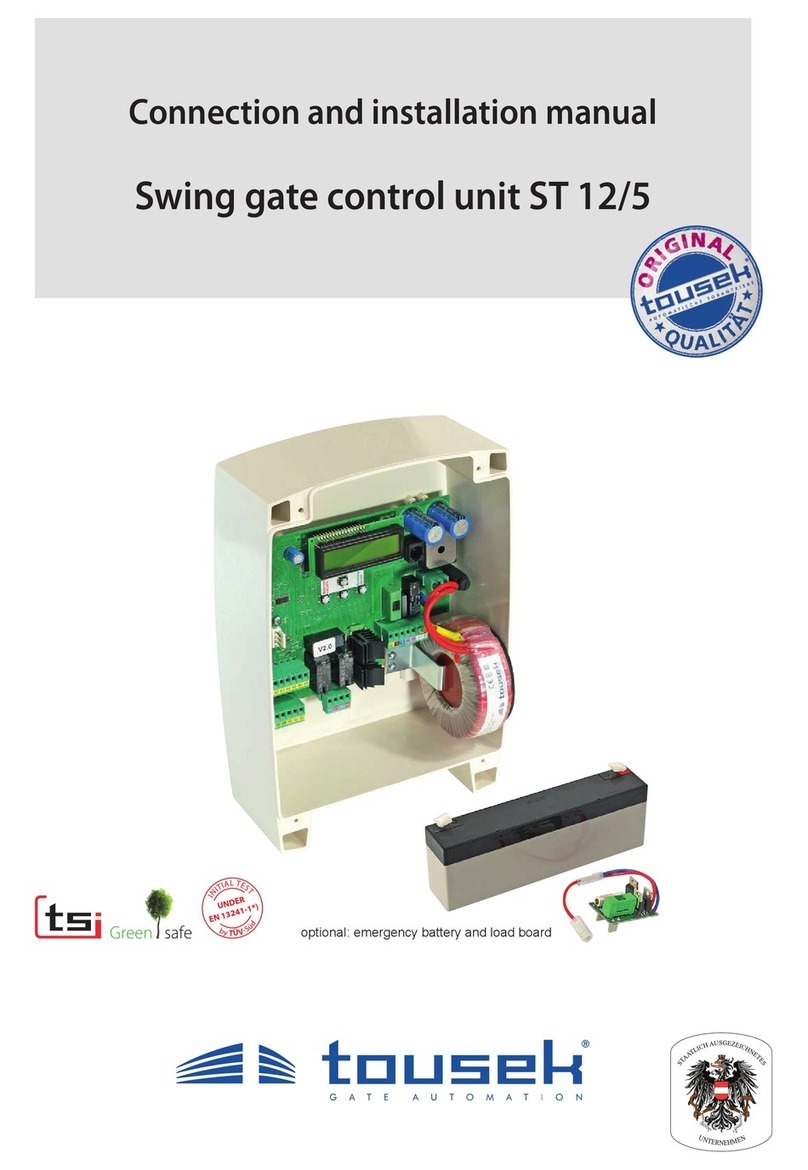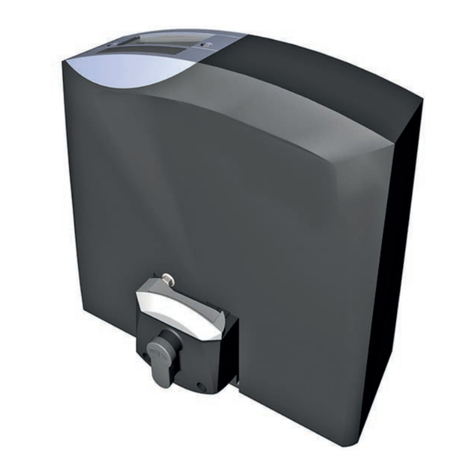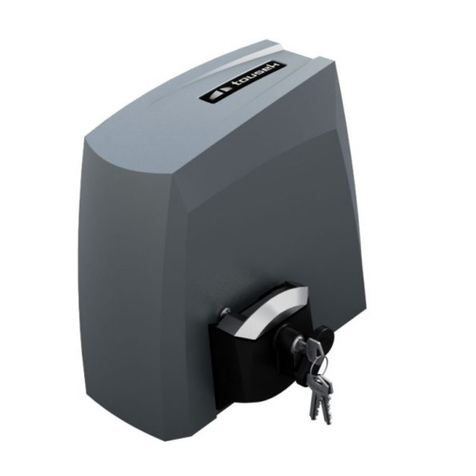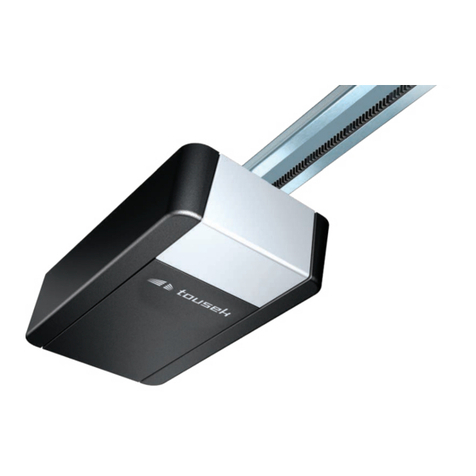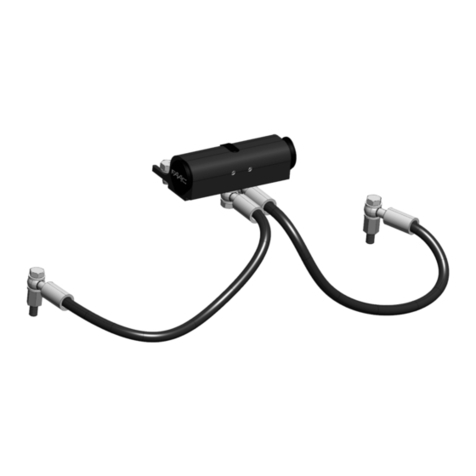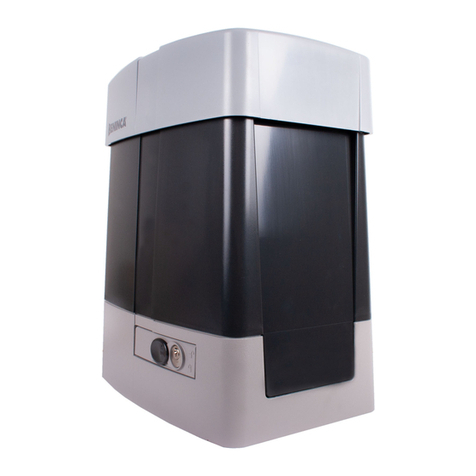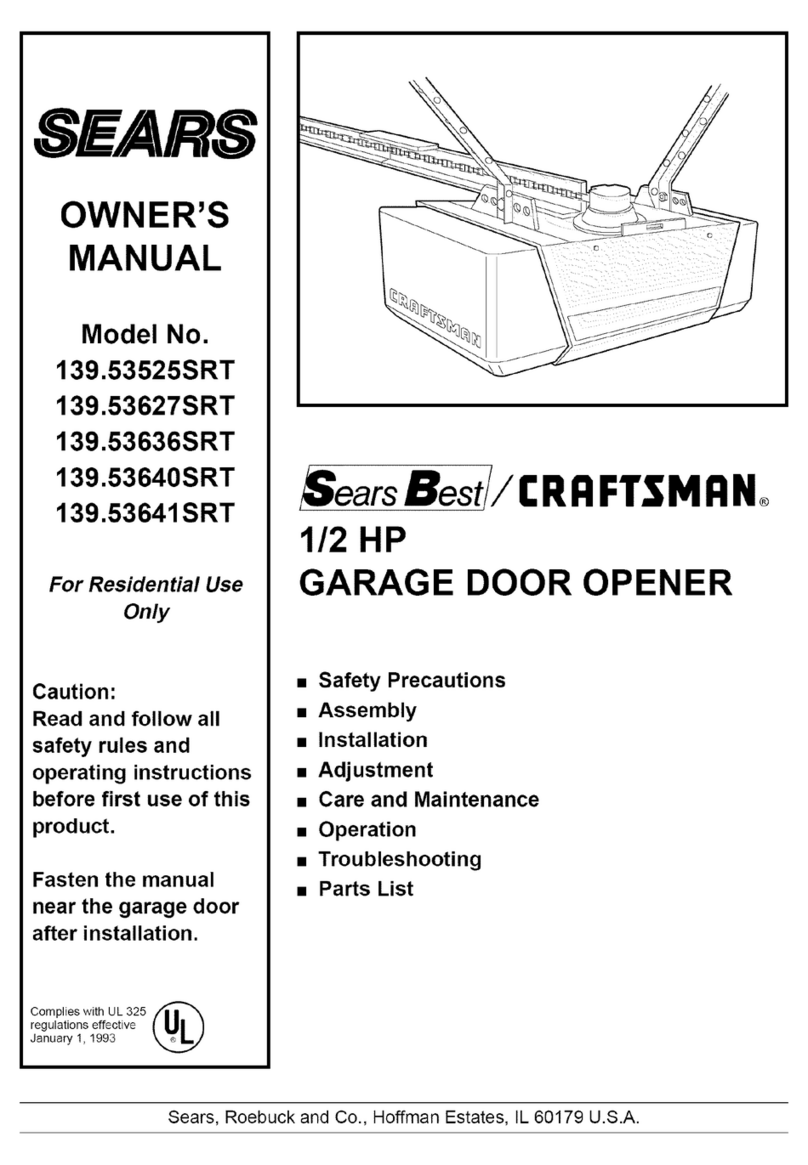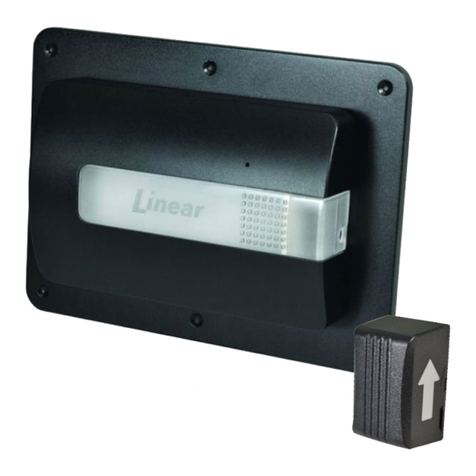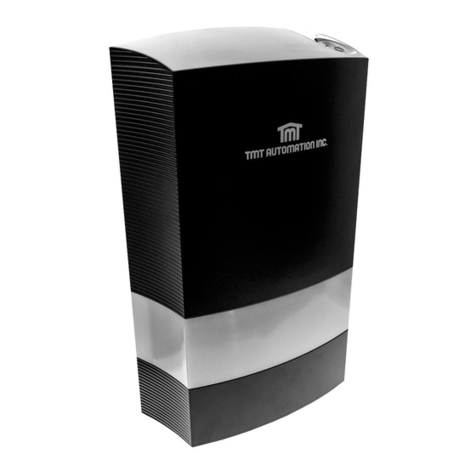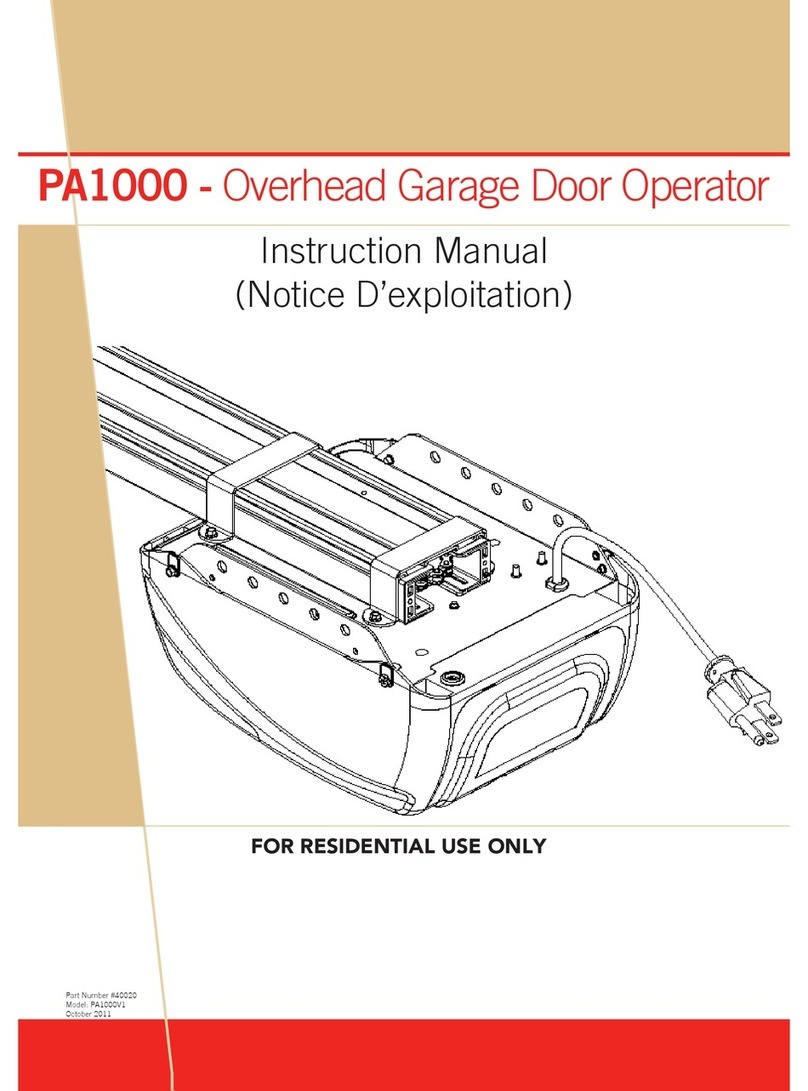tousek TPS 20 User manual

Mounting and installation manual
Master / Slave combination TPS 20
for opposite sliding gates
TPS 20
Safety Sensor

- 2 - tousek / EN_TPS-20-M-S_09 / 25. 03. 2020
This manual is the sole property of the TOUSEK Ges.m.b.H. and may not be made available to competitors. All rights reserved. No part of it may be reproduced without our prior
written permission. We will not accept liability for any claims resulting from misprints or errors. This edition of the manual replaces all earlier publications of the same.
Index
Important warning and safety notes for mountinga and operating ................................................................... 3
1. Notes, general characteristics, function, technical data .................................................................................. 4
2. Mounting ........................................................................................................................................................ 5
Emergency realease................................................................................................................................... 8
3. Control unit TPS 20 ......................................................................................................................................... 9
Programming, Menu structure............................................................................................................ 12, 13
Connections and adjustments ................................................................................................................. 14
Buttons/switches................................................................................................................................. 14
Safety.................................................................................................................................................. 16
Safety edges....................................................................................................................................... 18
Motor................................................................................................................................................... 20
Operating mode .................................................................................................................................. 20
Lamps / Lights .................................................................................................................................... 22
Diagnosis ............................................................................................................................................ 23
4. Connection radio receiver ............................................................................................................................. 24
5. Commissioning ........................................................................................................................................ 25–27
6. Error diagnosis ............................................................................................................................................... 28
7. Cable plan ...................................................................................................................................................... 29
8. Dimensioned drawings................................................................................................................................... 30
Declaration of incorporation ........................................................................................................................... 31

tousek / EN_TPS-20-M-S_09 / 25. 03. 2020 - 3 -
GENERAL WARNING AND SAFETY NOTES
• These installation and operating instructions form an integral part of the product “sliding gate operator”. They have been
specically written for professional installers trained and skilled in the trade and should be carefully read in their full length
before carrying out the installation. They describe the proper installation and operation of the sliding gate operator only,
not of the overall device “automatic gate”. After the installation this manual has to be handed over to the user.
• Installation, connection, adjustments, putting into operation, and servicing may only be carried out by trained profession-
als in full accordance with these installation- and operating instructions.
• Before carrying out works at the gate-system, the power supply has to be turned o.
• The EU Machine Directive, laws and rules concerning the prevention of accidents, and laws and standards which are in
force in the EU and in the individual countries have to be strictly followed.
• The TOUSEK Ges.m.b.H. cannot be held liable for any claims resulting from disregards of the laws and standards in
force during the installation and operation.
• The packaging materials (cardboard, plastic, EPS foam parts and lling material etc.) have to be properly disposed of
in accordance with the applying recycling- and environmental procection laws. They may be hazardous to children and
therefore have to be stored out of children´s reach.
• The product is not suitable for installation in explosion-hazardous areas.
• The product may only be used in accordance with its original purpose, for which it has been exclusively designed, and
which is described in these installation and operating instructions. The TOUSEK Ges.m.b.H. rejects any liability if the
product is used in any way not fully conforming to its original purpose as stated herein.
• Children have to be instructed, that the gate facility as well as the belonging parts may not be used improperly, e.g. for
playing. Furthermore handheld transmitters have to be kept in safe places and other impulse emitters as buttons and
switches have to be installed out of children‘s reach.
• Before beginning with the installation the installer has to make sure that all mechanical components of the gate facil-
ity, like carrier prole/rail, gate frame and panels, guiding elements etc. are suciently supportive and resistant for the
purpose of gate automation.
• All electrical installations have to be made in full conformity with the applying rules and laws (e.g. using a fault current
circuit breaker, proper grounding etc.).
• An all-pole disconnecting main switch with a contact opening-gap of minimum 3 mm has to be foreseen.
• The electric motor heats up during operation. Therefore the device should only be touched after it has cooled o.
• After installation the proper function of the gate facility and the safety devices has to be checked!
• The TOUSEK Ges.m.b.H. rejects any liability for claims resulting from usage of the product in combination with compo-
nents or devices which do not fully conform to the applying safety laws and rules.
• Only original spare- and replacement parts may be used for repair of the product.
• The installer has to inform the user about all aspects of the automatic operation of the complete gate facility, as well as
about emergency operation. The installer further has to supply to the user all instructions relating to the safe operation
of the gate facility. The installation and operating instructions also have to be handed over to the user.
• Please notice that the warranty will not be applicable if the label with the engine number has been removed or
damaged.
Maintenance
• Maintenance works may only be carried out by qualied personnel.
• Check the proper sensitivity setting of the ARS safety reverse system once a month.
• Check the proper function of the emergency release mechanism periodically.
• Check if all mounting screws are securely fastened periodically.
• Remove dirt deposits from the operator and gear rack periodically.
• Maintenance and servicing of the complete gate facility has to be carried out according to the gate builder´s/
installer´s instructions.

- 4 - tousek / EN_TPS-20-M-S_09 / 25. 03. 2020
1. General Sliding gate operator TPS 20 / Master-Slave
Characteristics TPS 20
• Suitable for heavy duty use (80% duty cycle)
• Large, illuminated LC-Display (2x16 characters)
• Clear text menu programmable via four buttons
•
Operation mode is selectable (Impulse, Automatic, Deadman)
• Free adjustable partial opening for pedestrians or
car/truck function
• Distance measurement made via speed sensor
(without limit switches)
• Adjustable soft stop (distance and speed)
• Ramp shaped soft start (approx. 1s)
• ARS – Automatic Reversal System
• Mechanical brake for safe gate stop
• Permanent self-regulating force with boost function
(increased start force)
• Electronic monitoring of emergency release
•
Direct connection of four separate 8,2 kΩ safety contact edges
• Input for gate back area surveillance
• Status display for safety and button/switches inputs
• Self-monitoring of photocell
• Connection slot for radio receiver
• Optional, external gate status display (e.g. for concierge)
• Optional courtyard lamp module (230V, 100W)
• 2 x 130mm DIN rail for additional accessories
• Dimension (W x H x D): 616 x 532 x 211mm
• Height adjustable gear wheel: 99–166mm
Technical data
Sliding gate operator TPS 20
Control unit integrated Max. drive 30m
Power supply 230V a.c., 50Hz duty cycle in
S3 mode 80%
motor voltage 230V a.c.
max. current consumption (excl.
equipment) 4A Ambient temperature -20°C +50°C
Gear wheel Z15M4 Protection class IP44
Max. gate weight 2000kg Torque sensor
Speed 14m/min
Torque 45Nm
Art.no.
Master 11110490
Increased starting torque 65Nm Slave 11110500
Optional equipment pluggable receiver • additional module für courtyard/control lamp • additional module for gate
status • Traffic light control unit • radio transmission system TX 310 • inductive system TX 400i
TPS 20

tousek / EN_TPS-20-M-S_09 / 25. 03. 2020 - 5 -
5
1
4
4a
7
6a
1a
1b
2
3
6
grounding screw
6a
2. Installation Sliding gate operator TPS 20 / Master-Slave
General installation notes
Before installing the tousek TPS 20 sliding gate operator we recommend checking the following points:
• Checking the gate structure:
On a gate which travels on oor rails please check the bottom rollers and the upper guide rollers and make
sure that there is no undue friction or jamming.
On a cantilever gate please check if the gate can be moved out of its end-positions without undue eort.
• The gate must travel in a stable manner without lateral movements of the gate panel.
• Make sure that the gate travels in a regular way without undue friction or jamming along the whole travel length.
• Make sure that there are stoppers at both ends of the track, preventing the gate from running over its travel limit.
ATTENTION !
• ATTENTION: Mechanical limits are necessary!
• ATTENTION: The sliding gate operator TPS 20 has been developed and designed for the automation of hori-
zontally travelling sliding gates. Gates on sloping tracks (i.e. gates which follow an inclined, non-horizontal,
travel path) must be automated with additional safety devices (which make sure that the gate cannot start
moving on its own from any gate position).
Technical layout TPS 20
(1) Ground plate
(1a) Cable entry
(1b)
Slotted holes (4x) for mounting
on
the foundation/ground
(2) Gear wheel
(3) Emergency release
(4) Control unit with optional
radio receiver (pluggable)
(4a) Boost condenser
(5) Speed sensor
(6) Motor-/gear unit
(6a) Motor condenser
(7) DIN rail for additional
equipment

- 6 - tousek / EN_TPS-20-M-S_09 / 25. 03. 2020
2
Z
110–177
212
65–132
Z15M4
15
2
1
1a 1b
4
3
98
4
NOTE concerning cable laying
• The electric cables have to be laid in insulating sleeves which are suitable for underground usage. The insulat-
ing sleeves have to be lead into the inner of the operator housing (see picture).
• 230V cables and control lines have to be laid in separate sleeves.
• Only double-insulated cables, which are suitable for underground usage (e.g. E-YY-J) may be used.
• In case that special regulations require another type of cable, cables according to these regulations have to be
used.
2.1 Installation of the motor Installation
After installing the protection tubes (check cable exit of operator (1a)) and having nished the concrete foundation,
the motor has to be bolted through the 4 slotted holes (1b) to the concrete foundation. It is particularly important that the
operator is mounted parallel to the gate panel, and that the measurements given in the drawing are kept.
Mounting dimensions TPS 20 (in mm)
(1) Ground plate
(1a) Cable inlet
(1b) Slotted holes (4x) for connection on the ground
(2) Gear wheel
(3) Emergency release
(4) Prole half cylinder of the
housing ap for emergency
release
(Z) Steel gear rack

tousek / EN_TPS-20-M-S_09 / 25. 03. 2020 - 7 -
Attention
• Do not weld the individual gear rack elements
together!
• With a gate weight of >1000 kg we recommend using
racks in a wider version.
L
D
• Disengage the motor from the output drive pinion with
the emergency release lever (see emergency release for
instructions) and open the gate completely.
• Install the spacer tubes (D) with the help of the bolts and
washers on the rst meter of gear rack
• Make sure that the bolts/screws sit in the top end of the
vertical slots (L), then tighten them.
• Place the rst gear rack element on the drive pinion and
x it in place with a screw clamp.
• Move the gate by hand until reaching the end of the rst
gear rack element, then weld the rst, second, and third
spacer tube to the gate
• Proceed with the other gear rack elements in the same
manner.
• Before xing the second meter of gear rack it is es-
sential to place another gear rack element under the
rst and second gear rack elements, thereby making
sure that the gearing module between the two gear
rack elements will be exactly kept (see illustration).
• After installation of the gear rack please loosen the
fastening bolts slightly and rise the gear rack a little
along the vertical slots, creating a distance of approx.
1 mm between the ank of the drive pinion and the
gear rack.
• The gear rack elements can also be installed without weld-
ing, i.e. by screwing them to the gate frame together with
the spacer tubes. Apart from that the gear rack elements
have to be installed in the same manner.
2.2 Installation of the gear rack Installation
approx.
1mm

- 8 - tousek / EN_TPS-20-M-S_09 / 25. 03. 2020
3a
3b
CLICKCLICK
CLICKCLICK
Montage- und Betriebsanleitung
Schiebetorantrieb TPS 20
V2.6.004
TPS20 TPS20N TPS20 PRO
SafetySensor
2.4 Dismantling
The dismantling of motor is made the other way around of mounting.
Before dismantling please plug o power supply of motor !
2.3 Emergency release in case of power failure (note for the user) M/S TPS 20
In case of a power failure or other defect the drive pinion
can be disengaged from the gearmotor as follows:
• Switch o power supply !
For emergency release of the TPS 20 the hous-
ing ap, which can be locked with a prole half
cylinder, must rst be opened!
You will nd the emergency release key
packed together with the installation manual.
• Turn the lock cover (3a) in counter-clockwise direction,
until the emergency release key (3b) can be inserted.
Now turn the key (3b) counter-clockwise to the stop, until
you hear a click and it reaches the unlocked position.
• Now the gate can be opened and closed by hand.
Re-engaging the emergency release mechanism:
To return to normal motor operation please turn back
the key to its original position.
Important
• After the key has been turned back, slowly move
the gate manually in its travel direction until you
can hear that the gearing has re-engaged!
Remove the key afterwards.
With next command the motor searches the open position
(a new learning of end positions is not necessary).

tousek / EN_TPS-20-M-S_09 / 25. 03. 2020 - 9 -
Overview of the control unit
Elements of control board
(K) Terminal blocks
(B) bus system terminals 88/89 (connection Master/Slave)
(S) Sensor plug
(D) Display plug or TC-/TSI-connection
(optional „tousek-connect“ / „tousek service Interface“)
(FE) Slot for optional radio receiver
(page 24 for connection)
(ZM) Connection slot for optional module
(page 21)
(F) Primary fuse T 6,3A
(T) Transformer
3. Control board Sliding gate operator TPS 20 / Master-Slave
FE
–
ESC ENTER
+
Display
T
ZM
B
S
D
F
K
Grounding
The grounding is made at
the grounding screw of
the operator housing!
Attention
During connection, adjustment and maintenance works please take care, that the electronic circuit board won´t be
damaged by moisture (rain).
Important
The optional „tousek-connect“ or the
„tousek service interface“ must be
connected with socket (D)!

- 10 - tousek / EN_TPS-20-M-S_09 / 25. 03. 2020
3.1 Terminal assignment Sliding gate operator TPS 20 / Master-Slave
Connection Master-Slave central unit
• In order to connect the master to the slave control unit the teminals 88 and 89 of the bus system ahve to be
connected to each other.
• The max. cable length between the sliding gate openers is 25m.
• Cable type: eg: PVC control cable YSLY 2 x 1mm2 or equivalent.
pre-wired
grounding
power supply
230V a.c.
signal lamp 230V,
max. 40W
0 1 210 11
30 31 32 30 33 30 34
to slave
control unit
power supply
photocell transmitter
power supply photocell receiver
and accessories, max. 0,3A
common photocell contact
photocell contact
photocell contact (back area)
bus system
control unit
SLAVE
low
high
88 89
transmitter
receiver
88 89 41 42 43 44 45 46 48
emergency release
common
main safety sensing edge
common
side safety s. edge 1 OPEN
common
side safety s. edge 2 CLOSE
common
side safety s. edge 3 OPEN
brown
blue or gray
black
green/yellow
28 29 20 21 22 23 8 9
brake 230V a.c.
motor 230V a.c.
grounding
additional condenser
common
STOP switch
IMPULSE switch
common
CLOSE switch
common
pedestrian switch
8,2kOhm
8,2kOhm
8,2kOhm
8,2kOhm
58 59 50 51 50 52 50 55 50 56
If no stop switch is con-
nected, terminals 30/31
have to be wire-bridged
(the jumper is set in the
factory).
Master central unit Terminal assignment
Function main safety sensing edge (MCE):
Safety during closing
Function side safety sensing edges (SE):
Safety during opening: SE1, SE3
Safety during closing: SE2
SE2
MCESE3
SE1
OPEN CLOSE
Master Slave
CLOSE OPEN
The stop input (t.30/31) has no emergency stop function! - In order to ensure the emergency stop function,
provide the supply line with an all-pole disconnecting emergency stop switch, that locks after actuation!

tousek / EN_TPS-20-M-S_09 / 25. 03. 2020 - 11 -
Connection Master- Slave central unit
• For the connection of the master control unit to the slave one the terminals 88 and 89 of the bus system have
to be connected to each other.
• The max. cable length between the sliding gate motors is 25m
• Cable type: eg: PVC control cable YSLY 2 x 1mm2 or equivalent.
Slave central unit Terminal assignment
30 31 32 30 33 30 34
to master
control unit
bus system
low
high
88 89
88 89 41 42 43 44 45 46 48
wire bridge
(cannot be
removed!)
control unit
MASTER
pre-wired
grounding
power supply
230V a.c.
signal lamp 230V,
max. 40W
0 1 210 11
emergency release
common
main safety sensing edge
common
side safety s. edge 1 OPEN
common
side safety s. edge 2 CLOSE
common
side safety s. edge 3 OPEN
brown
blue or gray
black
green/yellow
28 29 20 21 22 23 8 9
brake 230V a.c.
motor 230V a.c.
grounding
additional condenser
8,2kOhm
8,2kOhm
8,2kOhm
8,2kOhm
58 59 50 51 50 52 50 55 50 56
Function main safety sensing edge (MCE):
Safety during closing
Function side safety sensing edges (SE):
Safety during opening: SE1, SE3
Safety during closing: SE2
SE2
MCE SE3
SE1
OPEN CLOSE
Master Slave
CLOSE OPEN
Warning notes
• Before removing the control cover, the main switch must be turned o!
• If the control is power supplied, its inner part is under voltage.
• In order to avoid electrical strokes, the safety regulations have to be kept.
• The device may only be connected by trained professionals.
• The product is not suitable for installation in explosion-hazardous areas.
• An all-pole disconnecting main switch with a contact opening gap of min. 3 mm has to be foreseen. The gate
facility has to be secured according to the valid safety regulations!
• IMPORTANT: The control lines (sensor, buttons, radio, photocells, etc.) have to be laid separately from the
230V lines (supply line, motors, signal lamp).

- 12 - tousek / EN_TPS-20-M-S_09 / 25. 03. 2020
3.2 Adjustments - overview Sliding gate operator TPS 20 / Master-Slave
The dierent menu points are indicated as follows:
= selectable settings = factory settings = status display
Gshows the menu points which are in the “ BASIC SETTINGS”
Display
–
ESC ENTER
+
• The program menu is divided into “BASIC SETTINGS” and “MENU CONTROL”
BASIC SETTINGS
• When entering the programming of the control unit for the rst time you will see the BASIC SETTINGS
(„Putting into operation“ page 25).
• Here the necessary adjustments which are necessary for the use of the operator/gate can be set quickly.
• For advanced settings/programming please choose the menu point “menu control”.
MENU CONTROL
• For futher programming you will reach immediatly the MENU (CONTROL) (Basis settings are skipped)
• The main menu contains all possible settings. In the slave control unit you can select only a part of the menu options
described in the menu structure (marked with “M / S”). All other functions are taken over by the master control!
Programming menu Adjustments - overview
Programming buttons Adjustments - overview
• Before starting the programming, please choose the language. Use the buttons +or -to choose menu langua-
ge and conrm with ENTER.
• The setting of the language must be done in the master and the slave controller.
Note: Language selection can also be chosen by pressing the ESC button for 5s, from any position in
menu.
• The text display informs about behaviour, chosen menus
and adjustment of dierent settings.
• The programming of the control is carried out with the help
of four buttons (+, -, ENTER und ESC).
• Scrolling through the available menu points (up/
down) or the adjustment of a parameter (value in-
crease/decrease) is carried out with buttons +and –.
AUTO-COUNT: when holding one of the buttons the value
changes automatically.
• When pressing the ENTER-button a conrmation for
entering the shown menu point, resp. for accepting the
shown value of a parameter is given.
• When pressing the ESC-button you return to the superior
menu point. Possibly changed adjustments of a parameter
are rejected with this button (the former values will remain).
• AUTO-EXIT: if no button is pressed during 1 min. then the
menu switches automatically to the “ready” menu (wihtout
saving changed parameters)

tousek / EN_TPS-20-M-S_09 / 25. 03. 2020 - 13 -
Main layer Sub layer Settings/adjustments
buttons/switches
page 14 M
impulse button OPEN/STOP/CLOSE
OPEN/CLOSE/OPEN
OPEN
DEAD MAN
*) if impulse button is set to
DEADMAN, then the pedestrian
and close button are also set au-
tomatically to DEADMAN mode.
(not selectable under „pedest.-
button“)
M
pedestrian button OPEN/STOP/CLOSE
OPEN/CLOSE/OPEN
OPEN
DEAD MAN *)
Mmotor partial opening Master
Slave
Master and Slave
safety
page 16
MGphotocell active
not active
MPHC- back area not active
active
MPHC-function when closing reverse
stop - after release open
during closing stop, then close
M
PHC- pause time no inuence of photocell
abort pause time
re-start of pause time
immediate close after opening
MPHC- self test active
not active
safety edges
page 18 M/S
GMain clos. edge active
radio edge
TX 400
not active
M/S GSide edge 1 OPEN active
not active
M/S Side edge 2 CLOSE active
not active
M/S
Side edge 3 OPEN active
radio edge
TX 400
not active
M/S SE-status display status display of safety sensing edges
motor
page 20
M/S max. force 25...100% [ increment 5 ] = 70%
M/S incr.start.force
OFF, 0,5...3,0
[ increment 0,5 ] = 2,0
M/S ARS-response time 0,15...0,95s [ increment 0,05 ] = 0,50s
M/S speed 40...100% [ increment 5 ] = 100%
M/S soft way 0...2m [ increment 0,1 ] = 0,5m
M/S
soft speed
30...60% [ increment 5 ] = 50%
M/S end position OPEN 0...-30 [ increment 1 ] = -5
M/S end position CLOSE 0...-30 [ increment 1 ] = -5
operating mode
page 20
Mimpulse mode Stop, start of pause time
impulse suppression when opening
pause time extension
M/S Gopening direction <<<–left
–>>> right
MGoperating mode impulse mode
automatic 1...255s [ increment 1 ]
Mpartial opening 10...100% [ increment 1 ] = 30%
Mautomatic mode complete/partial opening
only complete opening
only partial opening
Mpause time logic no inuence
always open in automatic mode
Madditional module courtyard lamp/control lamp
status display 1
status display 2
lights/lamps
page 22
Mprewarning OPEN OFF, 1...30s = OFF
Mprewarning CLOSE OFF, 1...30s = OFF
Mcourtyard lamp 1) OFF, illum. time 5...950s = OFF
Mcontrol lamp 1) illuminates when opening/closing
blinks slowly / illuminates / blinks
illuminates in open position
diagnosis
page 23
M/S status display status display of all inputs
Mdelete positions NO
YES
Mfactory setting NO
YES
M/S software version show software version
M/S serial number show serial number
M/S protocol show protocol notes
M/S status sensor show sensor
1) The menu points courtyard lamp and control lamp will only appear on display if in menu
„Additional module“ courtyard lamp/control lamp is selected.
Menu structure Adjustments - overview
+
–
integrated control board for sliders TPS 20 / Master-Slave
ESC ENTER
Note: some adjustments regarding function or operating logic can only be executed if gate is closed and if the display shows „ready“.
M selectable in Master control
M/S selectable in Master and Slave control

- 14 - tousek / EN_TPS-20-M-S_09 / 25. 03. 2020
the menu points selectable in the master control (= M) or in the master and slave control (= M/S ) are
indicated as follows:
= selectable setting = factory settings = status display
Gshows the menu points which are in the “ BASIC SETTINGS” of he Master control.
Furthermore, possible notes abouts connection and similar are assigned as follows:
M=concerns the master central unit, M/S = concerns the master and slave central unit
3.3 Connections and adjustments Sliding gate operator TPS 20 / Master-Slave
Warning
• Before removing the control cover, the
main switch must be turned o!
• If the control is power supplied, its inner part is under
voltage.
• In order to avoid electrical strokes, the safety regula-
tions have to be kept.
• The device may only be connected by trained profes-
sionals.
• The product is not suitable for installation in explosion-
hazardous areas.
• An all-pole disconnecting main switch with a contact
opening gap of min. 3 mm has to be foreseen. The
gate facility has to be secured according to the valid
safety regulations!
• IMPORTANT: The control lines (sensor, buttons, radio,
photocells, etc.) have to be laid separately from the
230V lines (supply line, motors, signal lamp).
As impulse emitters pushbuttons or key switches as well as external radio receivers with potential free make
contacts can be used.
Impulse button (terminals M 30/32) MButtons/switches
OPEN/ STOP / CLOSE impulse repetition (factory settings): After a command of the impulse switch the motor
starts an open or close movement. If the impulse switch is pressed again during this movement, the motor stops. With
the next command, the motor drives in the opposite direction of the last gate movement.
OPEN / CLOSE / OPEN impulse repetition: After a command of the impulse switch the motor starts an open or close
movement. If the impulse switch is pressed again during this movement, the motor reverses.
•In this operation mode it is not possible to stop the motor with the impulse switch – it always
travels until reaching an end position. (Opened or closed position).
• for the function OPEN/CLOSE/OPEN we strongly suggest the installation of a photocell!
OPEN: Only open commands are accepted of the impulse switch. Closing the gate with the impulse switch is not
possible.
DEAD-MAN: The motor opens as long as the impulse switch is pressed – closing the gate with the impulse switch is
not possible. As soon as the switch is released, the gate stops. If hold to run operating mode is selected, the radio
receiver slot (FE) is set out of order for reasons of safety.
Positioning / initial operation with impulse button (M
terminal 30/32) in deadman mode:
IMPORTANT: Press and hold the impulse button until the operator moves the gate in open and close
position and the display shows „ready“.
After carrying out an emergency release or after a power failure, press and hold the impulse button until
the gate is in open position and the display shows „gate open“.
(Putting into operation page 25)
Buttons / switches Connections and adjustments

tousek / EN_TPS-20-M-S_09 / 25. 03. 2020 - 15 -
Pedestrian button (terminals M30/34) MButtons / switches
OPEN/ STOP / CLOSE impulse repetition: An impulse through the pedestrian button-while the gate is in motion
causes gate stopping. If the gate is within the pedestrian area, then an impulse through the pedestrian button causes
inversion of the direction.
If the gate is in complete open position an impulse through the pedestrian button causes a movement in CLOSE di-
rection and the gate stopps at pedestrian OPEN position.
OPEN / CLOSE / OPEN impulse repetition:
If the gate is within the pedestrian area, then an impulse through the
pedestrian button causes inversion of the direction.
If the gate is in complete open position an impulse through the pedestrian button causes a movement in CLOSE direction
and the gate stopps at pedestrian OPEN position.
•In this operation mode it is not possible to stop the motor with the pedestrian button – it always
travels until reaching an end position. (Opened or closed position).
• for the function OPEN/CLOSE/OPEN we strongly suggest the installation of a photocell!
OPEN: Only open commands are accepted of the pedestrian opening button. Closing the pedestrian entry with the
button is not possible.
DEADMAN: The motor opens as long as the pedestrian button is pressed – closing the gate
with the pedestrian button is not possible. As soon as the switch is released, the gate stops.
If hold to run operating mode is selected, the radio receiver slot (FE) is set out of order for reasons of safety.
The DEAD MAN setting cannot be actively selected, but it gets automatically selected when the impulse
button is set on DEAD MAN.
•As pedestrian button you can use pushbuttons or key switches as well as external radio receivers with
potential free make contacts can be used.
Motor partial opening MButtons / switches
Master: partial opening by Master operator.
Slave: partial opening by Slave operator.
Master and Slave: partial opening by both operators.
As CLOSE-buttons you may use pushbuttons or key switches as well as external radio receivers with potential
free make contacts can be used.
CLOSE-button (terminals M 30/33) Buttons / switches
• A command with the CLOSE-switch engages closing of gate. In deadman mode the gate closes as long as the
CLOSE-switch is pressed/switched.
As soon as switch is released the gate movement stops.
STOP-button (terminals M 30/31) Buttons / switches
• when pressing the stop button the gate stops in any desired position.
As stop button a break contact has to be used.
If no stop button is connected, terminals 30/31 have to be wire-bridged.
31
30
The stop input has no emergency stop function! - In order to ensure the emergency stop function, provide
the supply line with an all-pole disconnecting emergency stop switch, that locks after actuation!

- 16 - tousek / EN_TPS-20-M-S_09 / 25. 03. 2020
photocell PHC- back area
CLOSE OPENOPEN CLOSE
PHC- back area
Important: Photocells notes
• The control unit has a power supply connection for a 24V a.c. photocell (LS):
supply LS-transmitter: terminals 41/42 / supply LS-receiver: terminals 43/44
Note: in „gate closed“ position the terminals 41/42 are being switched into energy saving mode (no current)
(only, if no TX 310 system is used) !
• The contact has to be closed when using powered and positioned photocells (opening contact).
Connection of the photocell contact: terminals 45/46, photocell back area contact: terminals 45/48
• When using two pairs of photocells please do not
install both photocell transmitters/receivers on the
same side (to eleminate interference between both) !
Exception: photocells with SYNC function allow the
installation of both photocell transmitters/receivers on
the same side without causing interference to each
other.
• Photocell self-test function: The control unit has a monitoring function for the connected photocells. A test is triggered
by each impulse and will be checked if the receiver of the photocell responds to the signal from the photocell transmit-
ter. If there is no communication between the photocell receiver and transmitter the control unit responds with an error.
The deactivation of the self-test function is only allowed if the safety installations correspond to the category 3 !
• The exact function of the photocells depend on the programming of the control unit.
Photocell function please see menu point SAFETY / photocell function or photocell with pause time
• youwillnddetailedinformationinthecorrespondingphotocellmanual.
GPhotocell (contact: terminals 45/46) MSafety
active: to be selected, if photocell should be triggered.
not active: to be selected, if photocell should not be triggered..
PHC- back area (contact: terminals 45/48) MSafety
not active: No monitoring by PHC-back area.
active: To be selected, if the back area of the gate has to be protected by a photocell during the opening movement.
An interruption of the photocell during the opening movement causes the motor to get stopped and remain stopped
as long as the photocell is interrupted. After releasing the photocell, the gate opens.
PHC-function (only photocell at terminals 45/46 is concerned) MSafety
when closing reverse: an interruption of the photocell during closing makes the gate reverse (open). In automatic
mode the gate closes as soon as the pause time has run out. In impulse operation another closing command has to
be given.
stop, after release open: an interruption of the photocell beam during opening or closing makes the motor stop as long
as the photocell stays interrupted. After release of the photocell, the gate opens. In automatic mode the gate closes as
soon as the pause time has run out, in impulse operation another closing command has to be given.
during closing stop then close: an interruption of the photocell during closing makes the motor stop as long as the
photocell stays interrupted. After release of the photocell, the gate closes.
Safety Connections and adjustments
Standard:
transmitter 1 receiver 1
receiver 2 transmitter 2
With SYNC-function:
transmitter 1 receiver 1
transmitter 2 receiver 2

tousek / EN_TPS-20-M-S_09 / 25. 03. 2020 - 17 -
PHC- pause time (only photocell at terminals 45/46 is concerned) MSafety
no inuence of photocell: the photocell doesn’t have any inuence on the pause time in automatic mode.
abort pause time: in automatic mode an interruption of the photocell during pause time shortens the pause time. After
release of the photocell the gate starts closing.
restart pause time: in automatic mode an interruption of the photocell during pause time, restarts the pause time. As
soon as the pause time has run out, the gate closes.
immediate close after opening: If the photocell is interrupted during the opening movement or in position open, the
gate starts closing as soon as it reached end position open after release of the photocell.
PHC- self test MSafety
active: photocell self-test is executed with an opening impulse (switch, button) in gate position „closed“.
not active: photocell self-test is not executed.
Attention
• The photocell self-test can only be deactivated by selecting „not active“.
• The deactivation of the self-test function is only permitted if the safety installations correspond to the
category 3 !
Important
• as the LS 45/2 has no SYNC-function, both photocell
transmitters and receivers must be mounted on dif-
ferent sides!
Back area photocell Tousek LS 45/2
as safety device
2 Photocells Tousek LS 45/2
as safety device
Photocell - connection examples
1 2
+ -
~ ~
12/24V
1 2 3 4 5
+ -
~ ~
12/24V
1 2
+ -
~ ~
12/24V
1 2 3 4 5
+ -
~ ~
12/24V
transmitter 1 receiver 1
receiver 2 transmitter 2
48
46
45
44
43
42
41
1 2
+ -
~ ~
12/24V
1 2 3 4 5
+ -
~ ~
12/24V
transmitter receiver
48
46
45
44
43
42
41
M
M
NO
NC
COM
NO
NC
COM
NO
NC
COM

- 18 - tousek / EN_TPS-20-M-S_09 / 25. 03. 2020
Safety edges Connections and adjustments
Safety sensing edges (main and side edges) M/S
• OBSTACLE DETECTION:
When a contact strip is triggered/activated then a change of direction is eected for 1 second.
After that the gate stops.
If more safety sensitive edges are required, as shown in the gure above, (e.g. second guide column),
these have to be connected in series to the respective terminals SE1 and SE2.
Example: W 8,2kΩ nal resistance
1 nal edge
2+3 passage edge
S to control board
When connecting one safety edge a nal edge (1) has to be used.
1
W
2 3 S
Main safety sensing edge
Side safety sensing edges
50
56
SE3
50
52
SE1
50
51
MCE
50
55
SE2
name in menu short name /
status display active in direction terminals choice
Main clos. edge MCE CLOSE 50/51
active
not active
radio edge TX
TX 400
Side edge 1 OPEN SE1 OPEN 50/52 active
not active
Side edge 2 CLOSE SE2 CLOSE 50/55 active
not active
Side edge 3 OPEN SE3 OPEN 50/56
active
not active
radio edge TX
TX 400
Side safety sensing edges:
Safety during opening: SE1, SE3
Safety during closing: SE2
Main safety sensing edge MCE:
Safety during closing
SE2
MCE SE3
SE1
OPEN CLOSE
Master Slave
CLOSE OPEN
MCE
SE1SE2
SE3
M/S
Important
• After giving the impulse to program the end positions, no other impulse must be given. Also the safety devices
mustn´t be triggered. This would lead to an interruption of the programming process.
• Therefore, the mechanical stops must be set so that the existing contact strips cannot be triggered.

tousek / EN_TPS-20-M-S_09 / 25. 03. 2020 - 19 -
Important
• During programming of motor the contact safety edges should not be triggered as this leads to an error
message - the limit stops have to be placed correspondingly.
GMain closing edge (terminals 50/51) M/S Safety edges
active: to be selected if the contact strip (8,2kOhm) of main closing edge should be evaluated.
Radio edge: to be selected if the contact strip (8,2kOhm) of main closing edge should be evaluated with the radio
transmission system TX 310.
TX 400: to be selected if if the contact strip (8,2kOhm) of main closing edge should be evaluated with the system
TX 400i.
not active: to be selected if the contact strip (8,2kOhm) of main closing edge should NOT be evaluated
GSide edge 1 OPEN (terminals 50/52) M/S Safety edges
active: to be selected if the contact strip (8,2kOhm) of side edge 1 OPEN should be evaluated.
not active: to be selected if the contact strip (8,2kOhm) of side edge 1 OPEN should NOT be evaluated.
Side edge 2 CLOSE (terminals 50/55) M/S Safety edges
active: to be selected if the contact strip (8,2kOhm) of side edge 2 CLOSE should be evaluated.
not active: to be selected if the contact strip (8,2kOhm) of side edge 2 CLOSE should NOT be evaluated.
Side edge 3 OPEN (terminals 50/56) M/S Safety edges
active: to be selected if the contact strip (8,2kOhm) of side edge 3 OPEN should be evaluated.
Radio edge: to be selected if the contact strip (8,2kOhm) of side edge 3 OPEN should be evaluated with the radio
transmission system TX 310.
TX 400: to be selected if the contact strip (8,2kOhm) of side edge 3 OPEN should be evaluated with the system
TX 400i
not active: to be selected if the contact strip (8,2kOhm) of side edge 3 OPEN should NOT be evaluated
SE-Statusanzeige M/S Safety edges
Status dsplay of safety sensing edges MCE main closing edge SE2
side edge 2 CLOSE
SE1 side edge 1 OPEN SE3 side edge 3 OPEN
e.g.
$$$$$$$$$$$$$$$$
$$$$$$$$$$$$$$$$
MCE SE1 SE2 SE3
Radio transmission system TX 310
•
Connection and detailed information of radio transmission system TX 310 see according manual..
Inductive system TX 400i
•
Connection and detailed information of inductive system TX 400i see according manual.
.
status: not triggered
status: triggered
status: contact strip not connected
or defect
status: contact strip deactivated in menu
$o
$x
$
$-

- 20 - tousek / EN_TPS-20-M-S_09 / 25. 03. 2020
Attention
With force adjustment the valid safety regulations and standards have to be strictly followed !
Max. force 70% (factory setting) M/S Motor
25–100% adjustable [increment 5]: determines the max. possible motor force.
Increased starting force 2,0 (factory setting)
M/S Motor
OFF, 0,5–3,0 adjustable [increment 0,5]: determines the increased starting force.
ARS response time 0,50s (factory setting)
M/S Motor
0,15–0,95s adjustable [increment 0,05]: determines, in which time the AR-System responds. The lower the value,
the more sensitive the sensor will react.
Speed 100% (factory setting) M/S Motor
40–100% adjustable [increment 5]: determines the speed of motor.
Soft way 0,5m (factory setting) M/S Motor
0–2m adjustable [increment 0,1]: determines the distance of soft run.
Soft speed 50% (factory setting) M/S Motor
30–60% adjustable [increment 5]: determines the speed during soft run. If the entered value for soft speed is higher
than normal speed the value will be rejected and automatically set to a value that is 5% below the set value for normal
speed.
End position OPEN -5 (factory setting) M/S Motor
0...-30 adjustable [increment 1]: for readjustment of the automatically detected OPEN limit position of gate (e.g. for
safety sensing barriers). With adjustment 0 the motor runs to the previously learned open position.
For a diminished drive distance the value can be extended to up to -30.
This adjustment is ONLY adopted in CLOSED-position.
Deleting the end positions by selecting „diagnosis / delete positions“ effects the reset of this setting.
End position CLOSE -5 (factory setting) M/S Motor
0...-30 adjustable [increment 1]: for readjustment of the automatically detected CLOSE limit position of gate (e.g.
for safety sensing barriers). With adjustment 0 the motor runs to the previously learned close position.
For a diminished drive distance the value can be extended to up to -30.
This adjustment is ONLY adopted in CLOSED-position.
Deleting the end positions by selecting „diagnosis / delete positions“ effects the reset of this setting.
Motor Connections and adjustments
Impulse mode MOperating mode
Stop (at opening) - start of pause time: An impulse during the opening movement stops the gate and starts pause
time in automatic operation. When the pause time has run out, the gate closes automatically.
Impulse suppression when opening: Commands received during the opening movement are suppressed,
commands during closing are accepted.
Pause time extension: A command during pause time restarts the pause time. If this menu point is chosen, an impulse
suppression during opening is active at the same time.
GOpening direction M/S Operating mode
<<<–left: gate opens to the left side (seen from inside)
–>>> right: gate opens to the right side (seen from inside)
This adjustment is ONLY adopted in CLOSED-position.
GOperating mode MOperating mode
Impulse mode: Impulse through impulse switch/button or CLOSE-button to start closing of gate.
Automatic mode, pause time 1-255s adjustable [increment 5]: gate closes automatically after the adjusted pause time
(Exception: see adjustment „Automatic mode“ / „only complete opening“).
Operating mode Connections and adjustments
soft start fixed: approx. 1s
left opening
right opening
Table of contents
Other tousek Garage Door Opener manuals
Popular Garage Door Opener manuals by other brands

Raynor
Raynor 545RGD Safety Signal owner's manual

Lomax
Lomax Delta 80-003 installation instructions

elsner elektronik
elsner elektronik KNX A2 Technical specifications and installation instructions
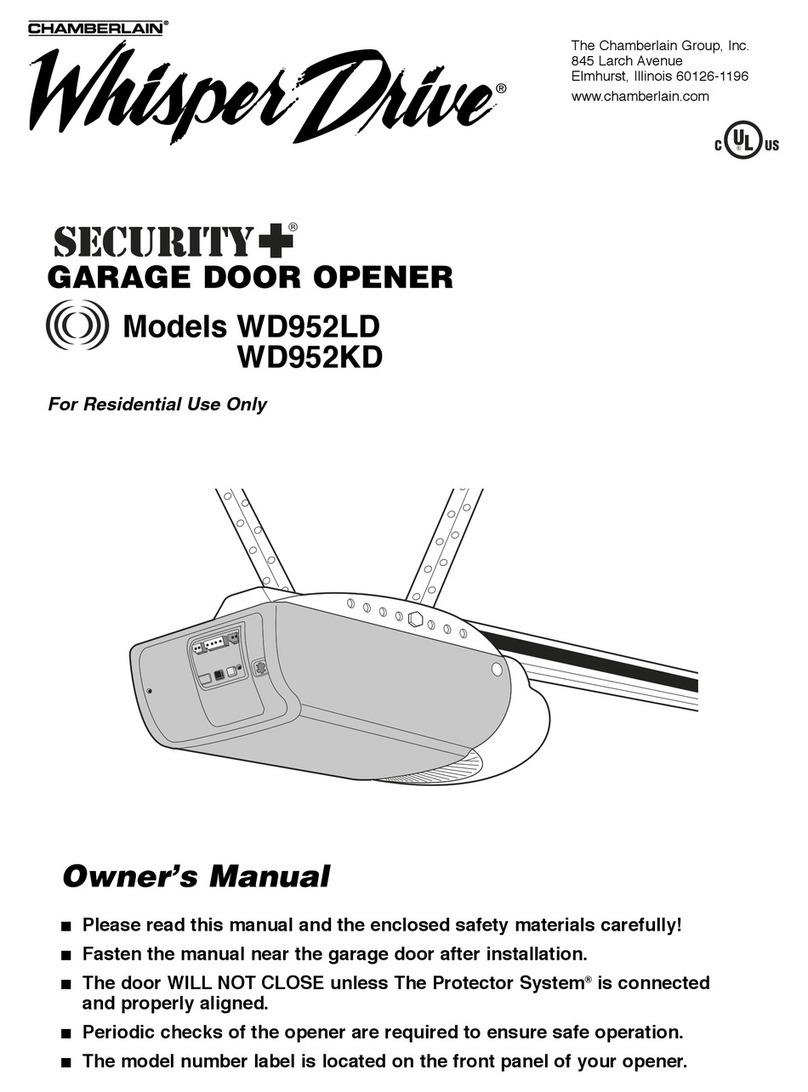
Chamberlain
Chamberlain Whisper Drive Security+ WD952KD owner's manual
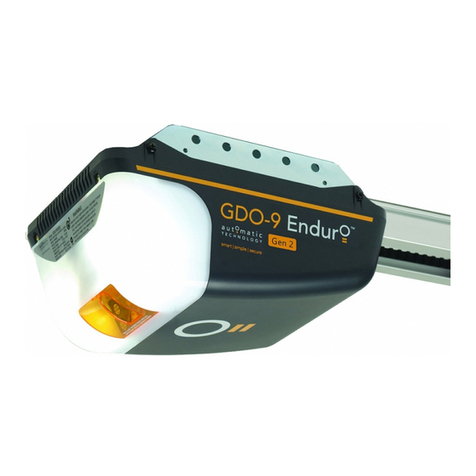
Automatic Technology
Automatic Technology GDO-9 ENDURO GEN2 Homeowner's manual

Matikgate
Matikgate BOLT User& installer's manual

Erone
Erone SIMPLY installation manual

krispol
krispol STARCUS K06 installation manual
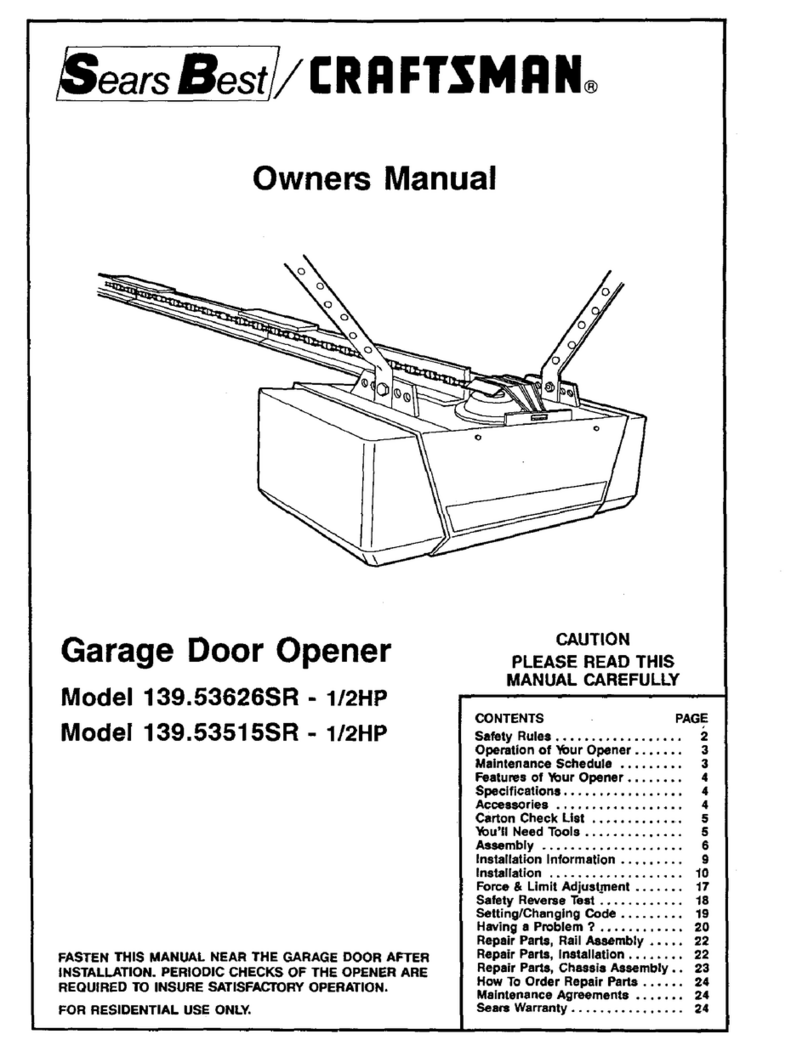
Craftsman
Craftsman 139.53515SR - I/2HP owner's manual

Stagnoli
Stagnoli ACHILLES-1200 instructions
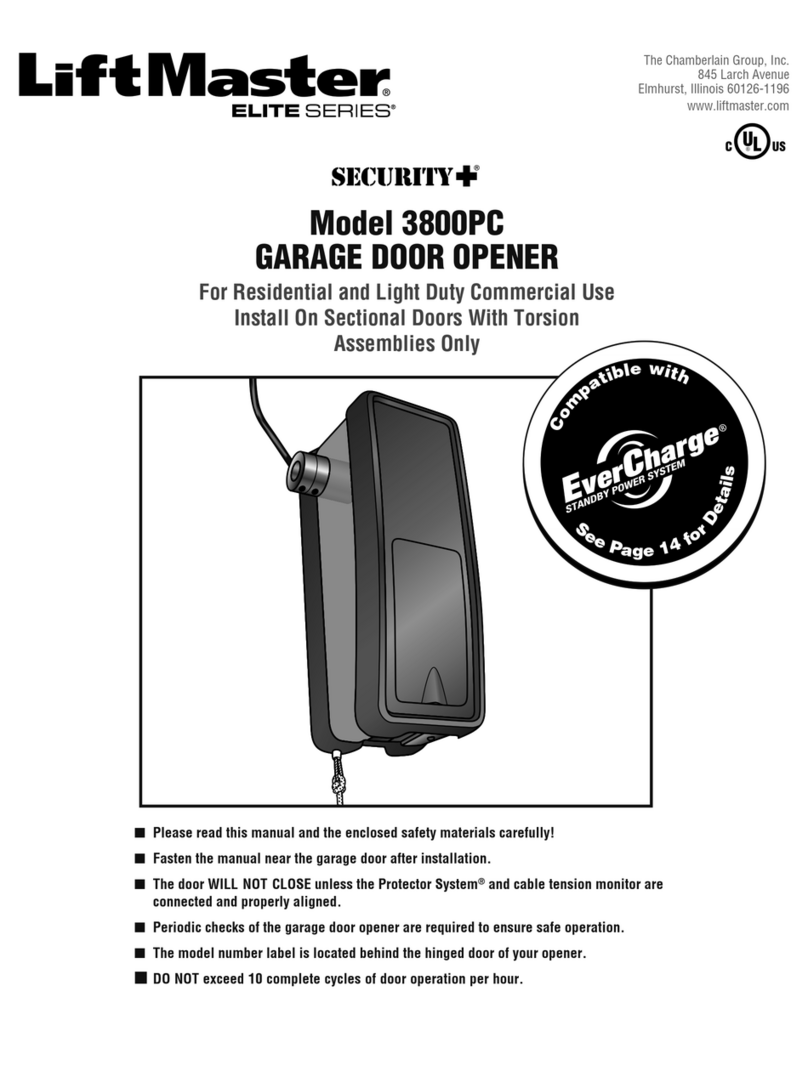
Chamberlain
Chamberlain LiftMaster Elite Security+ 3800PC owner's manual

Chamberlain
Chamberlain LiftMaster LM3800A instructions
